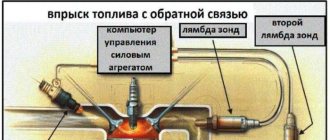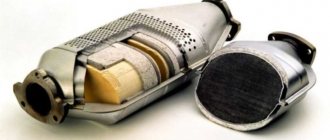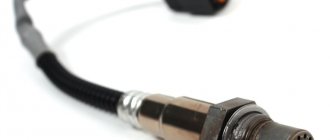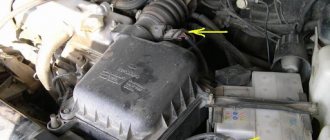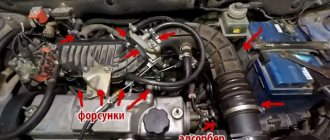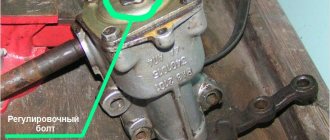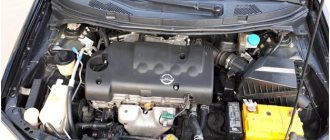This article will tell you everything you need to know about the P0171 code. You will also learn how to diagnose and fix the error yourself in the easiest and fastest way.
There is a lot of misinformation about the P0171 code and a lot of dubious advice on how to fix it. In this article, we will tell you how to properly diagnose this error code in order to find solutions as quickly as possible.
What does error code P0171 mean?
P0171 is triggered when the front oxygen sensor detects a lean mixture. This can be either a short-term or a permanent lean mixture.
The front oxygen sensors regulate the fuel mixture that leaves the engine. If the oxygen sensor detects a slight lean or rich mixture, it sends a signal to the engine control unit to adjust the mixture in the next combustion cycle to obtain the ideal fuel mixture for better fuel economy.
Oxygen sensors typically have a range of +/- 15% to adjust the fuel mixture.
If the fuel mixture is outside this range, the O2 sensor will not be able to adjust the mixture. The engine control unit (ECU) will initiate and store a fault code in memory. If the mixture is lean, error code P0171 will be triggered.
If the mixture is rich, then you will have a P0172 code. If you have a V-twin engine or two O2 sensors, you may also see a P0174 code, which means the mixture is also lean, but on the second cylinder bank.
Fuel system malfunction
Other causes of a lean mixture on the injector are due to improper operation of the vehicle's fuel system. As a rule, operational disruptions occur due to low-quality fuel, which is filled at little-known gas stations. One of the options for unstable engine operation and the formation of a lean mixture is clogged fuel cells of the car. In such cases, there is a misfire in the engine. As a result, the car may jerk. To prevent this from happening, it is necessary to purchase fuel only from trusted gas stations. Both fuel elements should also be replaced in a timely manner. Remember that one filter is presented on the injector in the form of a mesh and is installed directly into the fuel pump. The second element is most often located near the tank on the bottom of the car, less often in the engine compartment. To avoid over-leaning the mixture, it is necessary to change them at least once every 40,000 km. Sometimes this figure may be lower, since it all depends on the quality of gasoline.
Symptoms of P0171
If the fuel mixture is slightly lean, you will rarely have any other P0171 symptoms other than a "Check Engine" on your dashboard. If the mixture is very lean, the following signs may appear:
- "Check Engine" light is on.
- Hard idling or acceleration.
- Loss of power.
- Misfires.
- Low/high/floating speed XX.
- Difficult start.
- The engine may stall while driving.
Causes and how to determine them
The reasons for a poor air-fuel mixture (injector) are quite simple and lie in the operation of the car. They can be determined using engine diagnostics. First of all, its presence is visible from deposits on the spark plugs.
Also, the causes of a lean mixture on the injector are associated with malfunctions in the fuel injection system. It is responsible not only for supplying fuel to the power unit, but also for the correct preparation of the air-fuel mixture. In this case, the problem may be related to the fuel or air supply settings. Because of this, the mixture becomes leaner. To solve the problem, the car owner should seek help from specialists, since a failure of the injection system can include faulty sensors and incorrect adjustment of the throttle valve angles. It also happens that part of the firmware on the electronic engine control unit fails. It is worth remembering that the composition of the mixture may change by some values only for a minimally short time. Otherwise, you need to look for the problem and fix it.
P0171 Causes
There are many sensors or parts that can cause a P0171 code and a lean mixture. You will find the list below. And we'll start with the most common places to check when you have a lean fuel mixture. It is important to check for other trouble codes besides P0171. This may give you a clue as to where to start looking for the problem.
- You can read fault codes using a diagnostic scanner or an ELM327 adapter with the Torque program.
- Intake air leak (most common).
- Faulty PCV valve (PCV - positive crankcase ventilation system; often found on VAG cars such as Audi, VW, Seat, Skoda).
- Low fuel pressure (caused by a weak fuel pump, filter or fuel pressure regulator).
- Faulty EVAP valve (EVAP - gas tank ventilation system).
- Faulty O2 sensors.
- Faulty EGR valve (exhaust gas recirculation valve).
- Faulty MAF sensor (mass air flow sensor - MAF).
- Exhaust gas leak (in front of front oxygen sensors).
- Coolant temperature sensor.
- Faulty sensor wiring.
- Malfunction of the ECU/ECM/PCM control unit (rare).
Finding Vacuum Leaks
Air leaks can occur in any of the hoses that are connected to the engine intake manifold. Vacuum leaks are also possible through the intake manifold gaskets, throttle body, corrugation between the air filter and the throttle valve, injector O-rings, and idle air control.
Pay attention to such components as the crankcase ventilation system, the fuel system absorber, the vacuum brake booster and all the hoses that are connected to them. The cause of the problem could even be a crack in the exhaust manifold, through which excess air gets in before the oxygen sensor. This can also negatively affect the correct formation of the fuel-air mixture.
The simplest and most effective method of finding air leaks is to use a smoke generator. This device is easy to make at home, there are many instructions on the Internet, use one of them.
What is a "lean mixture"? This is an air-fuel mixture containing a LOT of air and a LOT of gasoline. Based on this information, you need to start looking for the causes of error P0171.
Let's start with the first one - too much air. Injection vehicles are equipped with air flow meters (MAF or DAMV). It is installed immediately after the air filter and counts all the air that is sucked into the intake manifold to form the air-fuel mixture. Based on the readings of this sensor, the controller knows how much air has passed and how much gasoline it needs to supply for a given amount of air.
If excess air enters the intake manifold, not taken into account by the flow meter, then there will be more air and, as a result, we get a lean mixture . The most difficult thing is that it is quite difficult to find where exactly this unaccounted air is sucked in.
The main places for air leaks are the intake manifold gasket, throttle body gasket, corrugation from the filter to the throttle body, IAC, injector O-rings, vacuum brake booster, canister valve.
And now we’ll look at 3, in my opinion, the most effective methods for finding air leaks into the intake manifold.
P0171 Possible solutions
There are many different solutions for the P0171 code. We will describe them, starting with the most common. Diagnostic tools that can help you troubleshoot problems are described in the diagnostics section below.
- Replace faulty vacuum hoses or gaskets around the intake manifold.
- Repair other intake leaks.
- Replace the PCV valve.
- Replace the fuel pump/fuel filter/fuel pressure regulator or repair the wires.
- Replace EVAP valve.
- Replace oxygen sensors.
- Replace the EGR valve.
- Replace the mass air flow sensor (MAP/MAF).
- Repair exhaust leak.
- Replace the coolant temperature sensor.
- Repair of faulty wires.
- Replace the ECU (ECM/PCM, rare).
Carrying out an inspection
Speaking about the lack of fuel, there are also three main reasons.
- The first includes problematic operation of the fuel pump, when it does not have enough power or it does not work as it should.
- Next comes the non-optimal resistance of the fuel filter.
- Well, the third reason will be a leak that may occur in the pressure regulator . Also, the breakdown may consist of simple contamination of the fuel injectors.
Error Resolution Table
| Problem | Symptoms | Causes | Solutions |
| Error P0171 | Check Engine Rough idling or acceleration Loss of power Misfire Low/high/floating speed XX Difficult to start Engine may stall while driving | Intake air leak (most common) Faulty PCV valve (common on VAG: Audi, VW, Seat, Skoda) Low fuel pressure (caused by weak fuel pump, filter or fuel pressure regulator) Faulty EVAP valve Faulty EGR valve Faulty O2 sensors Faulty MAF Coolant temperature sensor Faulty sensor wiring Faulty ECM/PCM (rare) | Replace faulty vacuum hoses or gaskets around the intake manifold Repair other intake leaks Replace the PCV valve Replace the EGR valve Replace the fuel pump/fuel filter/fuel pressure regulator or repair the wires Replace the EVAP valve Replace the oxygen sensors Replace the air flow sensor Repair exhaust leak Replace the coolant temperature sensor Repairing faulty wires Replace the ECU (ECM/PCM, rare). |
Injector problems
You don't have to be an expert to understand that the problem here lies in the operation of the injector. And first of all, before we start studying lean mixture, let’s try to find out what it even is. This is important only because such a reason can lead to expensive repairs to the car.
Why do jerks happen?
The presence of jerks while the car is moving is a problem that directly or indirectly indicates the presence of problems with the engine, or more precisely, a loss of power. In total, there are two features that affect the development of power in the engine - fuel supply and the ignition system.
If with the ignition, everything is more or less clear, due to the inspection of the generator, spark plugs, ignition wires for faults, and the battery for charge, then in the case of the ignition system everything looks much more complicated.
High voltage wires are marked with arrows
Inspecting the condition of the spark plugs
To ensure a successful engine start, it is necessary to mix the fuel and air mixture in ideal proportions; this is what the injector is responsible for.
It happens that when mixing these proportions, a malfunction occurs, and the mixture turns out to be rich or lean.
A clear example of the air-fuel mixture ratio.
In order for the car to obtain maximum power when burning fuel in the cylinders, it is necessary to bring its indicator to the level of 0.85 - 0.9, when excess oxygen = > 1 (at this indicator, gasoline burns completely without residue - approx.), and when there is a lack of oxygen, and the readings are equal. The main reasons for a lean mixture
The main and most important symptom that the system has a lean mixture is a stalling or unstable engine. And if the mixture is very poor, then it is possible that it will not start at all.
The cause of these problems is most often a clogged air filter (see “replacing the air filter”), clogged injectors, wear in the fuel pump, and there may also be air leaks into the system. All these reasons are, one way or another, related to the stable operation of the engine.
How to diagnose P0171?
Since the P0171 trouble code means the vehicle is running lean, it can be caused by many different sensors or faulty parts.
This guide is about how to fix the P0171 code the fastest way and what an experienced mechanic will do to find the problem. When performing these steps, you may need some tools to quickly and effectively troubleshoot problems. But you can do without them, try following the instructions.
1. Connect the charger to the car
The first step you should always take when diagnosing a car. You will often turn on the ignition while troubleshooting, and the vehicle voltage should not be low.
Low voltage may cause other unrelated trouble codes. In rare cases, low voltage can even damage electronics, so always use a charger when diagnosing.
2. Check all sensor parameters using an OBD2 scanner
If you have an OBD2 scanner, you can check all sensor parameters. Just check the values of the MAF, coolant temperature, boost pressure, intake temperature sensors and make sure the values are correct.
Many scanners have tables of base values that should be displayed at certain speeds and temperatures. Also, check the oxygen sensor parameters and make sure they are correct. Replace faulty sensors, clear error codes and try again.
You can also do it the old fashioned way and measure all the sensors with a multimeter. This will take a very long time and you have to find which values are correct. If possible, we always recommend using an OBD2 scanner.
3. Check for other fault codes
If you have measured all sensor parameters and are satisfied that they are correct, check for other stored and associated fault codes in the controller. They can tell you where to start your search.
Many problems with sensors occur periodically. When you check them, you get normal parameters, but while driving they may not work correctly and cause a P0171 code.
The control unit is smart. It recognizes the faulty value in just a second and this triggers a fault code. These are the trouble codes you should be looking for. If you receive another error code from any sensor, you need to start checking with the corresponding part of the car first. This can save a lot of time.
Check for inlet leaks
Air leaks are a common problem when it comes to the P0171 code. Leaks in the intake manifold/vacuum hoses/turbocharger can fool the MAF sensor and cause the mixture to lean.
The mass air flow sensor measures all the air entering the engine and reports this amount to the controller. The ECU then injects fuel into the engine depending on the amount of air. A leak can distort this value, resulting in a lean mixture.
The easiest way to find a leak is to use a smoke generator. They, unfortunately, are quite expensive for the car enthusiast. You can make a smoke generator yourself.
Video on how to find air leaks at home without a smoke generator:
And one more piece of advice. You can use a flammable spray like Quick Start or brake cleaner. Spray around the intake while the engine is idling. If the RPM increases, there is a leak in the spray area. For the same purposes, you can use a soap solution.
An air leak can often be found in the PCV valve, especially on VAG vehicles such as Audi, Volkswagen, Seat and Skoda. If you have one of these cars, check the PCV valve under the intake manifold or on top of the engine on newer 2-liter engines.
PCV valve
You should also check the EVAP valve, which controls fuel gases. A leaky or faulty EVAP valve can cause a lean mixture. You can test this valve by blowing through it to see if it is closed or not when it should be.
The problem often occurs in the hose between the intake manifold and the fuel pressure regulator. This causes low fuel pressure and sets the P0171 code.
Check fuel pressure
Low fuel pressure is a common occurrence with the P0171 code. Troubleshooting this problem can be quite difficult because you often check the fuel pressure only at idle. Low blood pressure can occur in other situations. This is usually solved by connecting a pressure gauge.
Many cars have a fuel pressure sensor that allows you to monitor the pressure while driving. But the problem is that this sensor may also be faulty. In this case, the controller will show a low fuel pressure error.
In any case, you need to check the fuel pressure at idle. This may indicate a faulty fuel pump or fuel filter. To check, you will need to connect a pressure gauge to the fuel line.
You should find out what pressure your car has. Disconnect the vacuum hose between the intake manifold and the fuel pressure regulator to obtain the correct value. You can ask a partner to rev the engine to see if the fuel pressure drops.
6. EGR check valve
An open EGR valve when it should be closed can fool the air flow sensor and cause a lean mixture. Checking the EGR valve can be a challenging task. This usually requires removing it or using a smoke generator.
Many OBD2 scanners have an electronic EGR test function. They check the air entering the engine as it opens and closes. This can often help locate a faulty EGR valve because the test will give a positive or negative result.
The ECU often recognizes faulty EGR valves and stores a fault code stored in the controller's memory, but not in all cases. So it's better to double check it. Faulty EGR valves causing P0171 are common on Opel engines. Clogged EGR lines on Opel engines can also cause this.
Here is a video on how to check the EGR valve:
Checking air leaks at the outlet
Air leaking into the exhaust system in front of the oxygen sensors can fool them and cause code P0171. To check for this, the easiest way is to start the engine and listen carefully for any leaks in front of the O2 sensors.
You can have someone plug the exhaust pipe to create pressure in the exhaust system. If you have a smoke generator, everything is even easier. Simply connect it to the rear exhaust pipe and check for smoke from potential leak areas.
It could also be the oxygen sensor that is causing the P0171 code, but this is something you should have already checked in the previous diagnostic steps.
Clean the mass air flow sensor (MAF)
Fine dust may pass through the air filter and collect on the sensor. This may cause the sensor to give incorrect readings of the amount of air entering the engine.
Cleaning the air flow sensor is often sufficient. This can be done using electrical contact cleaner or air flow sensor cleaner. You need to spray the cleaner on the sensor inside the housing.
Error "Lean mixture"
Error on the on-board computer screen
This is a lean mixture error.
Video on lean mixture and fuel economy from “ICE Theory”
In this case, the amount of fuel in the working mixture is too low, while too much air is supplied there.
A similar problem appears in a situation where the engine takes in a significant portion of air from the atmosphere for one of many reasons. Also, the problem may lie in insufficient fuel injection due to clogging or other problems.
Symptoms and behavior of the car with such an error
This phenomenon can lead to misfires, as well as delays that occur in the car’s response to pressing the gas pedal. The car may start to stall or stall at stops (idling).
In addition, when accelerating, a noticeable twitching is felt, and dips are observed during idle.
Well, the engine itself changes its sound, starting to work extremely unstable. In those engine monitoring and control systems that support Euro 2 and higher standards, there is a lambda probe. It is he who is responsible for controlling the quality of the mixture. It is optimal if there are about 14.7 parts of ordinary atmospheric air per part of fuel.
If there is a shift from this value by more than a quarter, the system will generate error message P0171.
How does a car behave with a similar problem?
If the engine receives too lean a mixture, this can cause the car to begin to “chop” at idle, and also overheat, since the rate of combustion of the mixture becomes much lower. If you listen closely, you may hear popping noises in the intake manifold. The revs pick up extremely slowly under load.
A lean mixture can be recognized by deposits on the spark plugs.
Burnout of valves and piston system
In the most difficult situations, if the engine overheats very much, this can lead to burnout of the valves and piston system , which entails serious costs for further maintenance and repairs.
A burnt valve will require serious financial investment in car repairs.
Strong vibration, the engine began to shake violently - symptoms of burnt valves
Still the same Avensis, general view of the head
Intake valve burnout
Burnt valve
The owner was lucky that the broken piece of the valve did not lead to a major overhaul of the engine.
It feels like someone just took a nice bite out of the valve.
High fuel consumption
If a car is used for a long time with such a problem, this can lead to very high fuel consumption, which occurs due to a slow increase in speed. So, drivers have to operate their car in lower gears more often. A lean mixture can occur when the supply balance of its components is upset.
Conclusion
- Intake air leaks are often the cause of P0171. And it needs to be checked first. The easiest way to check is to use a smoke generator. But there are also alternative methods.
- Low fuel pressure also often causes a P0171 code and should be checked with a manual fuel pressure gauge.
- A faulty PCV/EVAP is common on VAG vehicles such as Audi, VW (Volkswagen), Skoda and Seat. It should be checked if you have one of the machines listed.
- Faulty EGR valves are common on Opel engines. If you have such a car, first check the exhaust gas recirculation valve.
- Multimeters can be bought: here and here. Car chargers - here and here.
Previous post Error P0174 - what it means, symptoms, causes, diagnosis, solution
Next entry How to find air leaks at home
Causes of a lean mixture
There are several main reasons why the mixture is supplied to the car lean. But, they are all divided into two main groups: a large amount of air and a small amount of fuel.
A lean mixture error may occur in the case of excessive air supply, then the problem lies in the incorrect operation of the fuel flow sensor. This can happen when the channels become dirty. The second reason can be called the problem of vacuum leakage. And reason number three talks about the problem of air intake through the EGR valve when it is broken or does not close tightly enough.
Check the EGR valve
Checking the EGR valve (video)
In order to eliminate the EGR valve, it is necessary to remove it from the car and check its operation. The test is carried out with compressed air. Compressed air can be taken from a compressor, a tire pump, or, in extreme cases, from the tire itself. Learn more about video verification.
